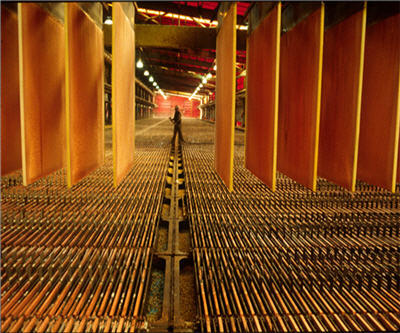
In late afternoon New York trade on Tuesday July copper changed hands nearly 2c lower at $3.073 a pound as weakening demand from China and the unraveling of copper-related financing deals worry the market.
Tuesday’s decline marks something of a reversal in sentiment after the metal hit a seven-week high on Monday following reports last week indicating that the Chinese State Reserves Bureau has bought up to 350,00 tonnes of copper in March and April to move into state warehouses.
Beijing, which has picked up metal on the open market before, were making the most of copper near four-year lows in mid-March.
Copper is down nearly 9% from opening levels for the year as the market adjusts to slower growth in China which consumes more than 40% of the world’s copper.
China’s copper imports have not slowed down however, rising a whopping 31% to 420,000 tonnes in March over last last year and bringing the first quarter total to a record-breaking 1.3 million tonnes.
But those numbers may be misleading and do not reflect a sharp fall-off in end demand.
That’s because much of that copper has been tied up in finance deals as collateral for trade credit and is not being put to industrial use.
Other industrial metals are also used in short-term financing deals, notable iron ore where some 40% of the record 110 million tonnes of the steelmaking raw material stockpiled at China’s ports, are believed to act as security for loans.
The portion of copper inventories used for financing – part of China’s vast shadow banking system – is believed to be much higher. Prompted in part by a weaker yuan – or more precisely a currency that’s no longer appreciating steadily – these deals are now being unwound supplying even more copper to the market.
Julian Jessop Head of Commodities Research at Capital Economics, an independent macro-economic adviser, in a new research note points out that “fresh signs that China is cracking down on the use of industrial metals as collateral have begun to unnerve markets”:
The immediate target of regulators is reportedly imports of iron ore by steel mills and traders. Hard data on the extent of this particular form of “shadow financing” is, by its very nature, sparse. But it seems likely that other commodities, notably copper, are used more widely for this purpose, not least because they are easier to transport and store.
Indeed, reliable sources suggest that new regulations due to take effect after the Labour Day holiday (1st – 3rd May) will raise deposit requirements on letters of credit (LCs), which have used commodities widely as collateral.
While price pain induced by the unwinding of these deals could be severe in the short and medium term, longer term weaker fundamentals are also clouding the outlook.
Capital Economics predict a price as low as $2.65 a pound ($5,800 a kilogram) by the end of the third quarter, below even the bearish predictions of other market analysts.
Thanks to the widespread use of the metal in construction, transport and manufacturing, copper is highly sensitive to an economic slowdown.
Worries continue to mount about the outlook for the Chinese property sector after the value of new homes sold fell 7.7% and new home starts dropped more than 25% during the first quarter.
China’s property sector which has enjoyed years of red-hot growth, is a key component of its economy and also accounts for a large proportion of all copper demand.
The supply side is also driving down price expectations, with a small surplus predicted this year.
Global mine production rose by 8% to 17.8 million tonnes last year, its fastest pace in over a decade thanks to marked expansion top producer Chile and the Democratic Republic of Congo.
Output is to top 22.2 million tonnes this year from just over 21 million tonnes in 2013 led by Codelco’s new 160,000 tonnes-plus Ministro Hales mine, Glencore’s Las Bambas project in Peru it sold to China’s Minmetals recently, the first full year of production at Rio Tinto’s Oyu Tolgoi mine in Mongolia and expansion at BHP Billiton’s already giant Escondida mine.
After an abnormally quiet 2013 with few supply disruption to existing operations, 2014 could yet turn out to be different.
Freeport McMoRan and fellow Indonesian copper miner Newmont Mining are deferring exports from Indonesia due to onerous new duties were slapped on copper concentrate exports at the start of the year.
Reuters reports last year’s supply surge largely came from brownfield expansions, but “this year’s will come from new mines with a higher risk of start-up problems, already foreshadowed with guidance downgrades and timeline delays at mines such as Oyu Tolgoi in Mongolia and Caserones in Chile .”
Image courtesey of Codelco